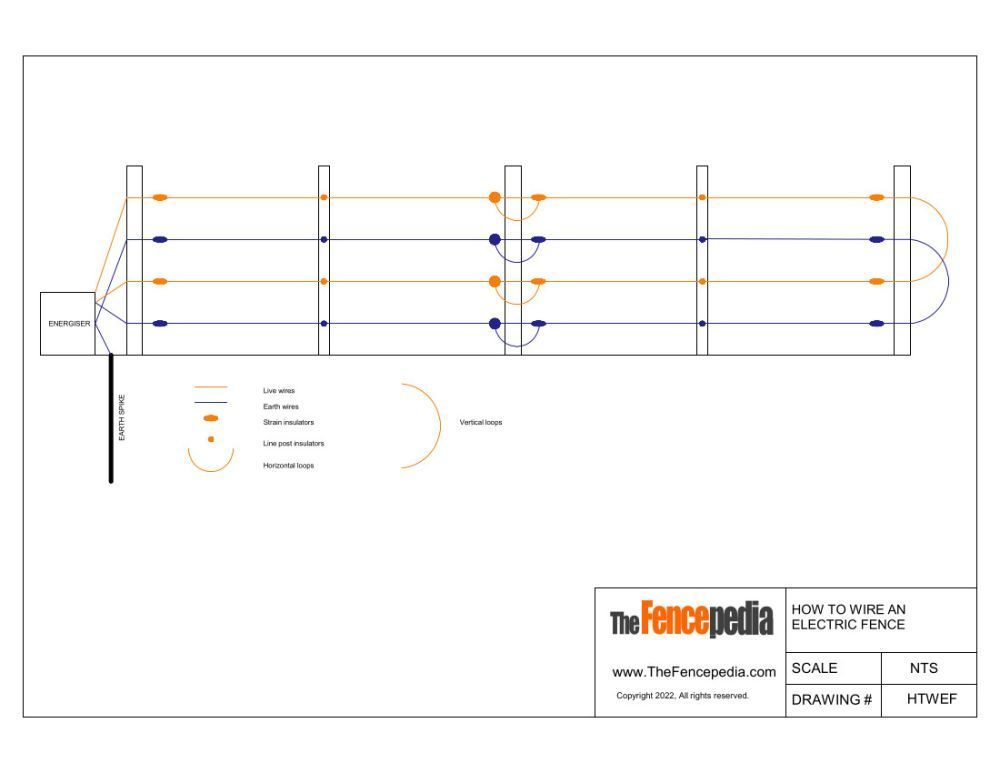
How to Wire An Electric Fence - with Downloadable Diagram
If you're not used to building electric fences, then you might be wondering just how you get the current to flow through the electric fence wires, avoid short circuits and generally build an electric fence that works. The good news is that this is not as hard as you think.
Whether you're building a simple single-zone, four-strand electric fence or something more complex, the basic answers to the question of how to wire an electric fence don't change. Learn more and don't forget to download our free diagram here!
Wires Out and Wires Return
The first thing you need to know about electric fences is that when you wire one, you are building a giant circuit, and circuits need to be closed to operate properly.
That means that your wires need to go out of the energizer, connect to the fence, generate current, and then that current needs to come back to a return wire that goes back to the energizer.
Most energizers have live out and live return and earth or grounding out and earth or grounding return. These circuits are indicated in orange and blue on our diagram.
Fence Earthing or Grounding
The next important thing you need to know before we get into the wiring of the fence itself is that you will need to ground or earth your electric fence by attaching a wire to an earth spike that is usually driven into the ground near the energizer. This helps to keep the fence safe and operating properly./
Tension Post Fittings
Electric fence grid wires, or the wires that are installed on the fence to carry the current around your fence have different fittings at different kinds of posts.
At tension posts, you will usually have strain insulators, which are often oval-shaped plastic fittings, and usually some kind of in-line tensioner, usually a ratchet type, on the other side. This helps to keep the fence properly insulated and ensures that wires stay taut. These tensioners are usually also attached to some kind of insulator, which we have not indicated on the drawing, but your electric fence supplier will be able to advise about the best tension post-straining equipment for the type of electric fence and wire type you're using.
Line Post Insulators
Electric fence wires need to be prevented from touching metal posts, or you will have lots of shorts and an electric fence that does not work properly.
This is achieved by installing line post insulators on all your intermediate or line posts. These are usually nail-on or screw-on plastic insulators that are simple to install.
Vertical and Horizontal Loops
The most important part of your electric fence wiring, and the thing that will ensure you have the necessary closed circuit are the "loops" which are simply short pieces of fence wire that are installed at tension posts to "bridge" the wires.
When you're doing horizontal electric fence loops, you're going to connect the wire on one side of a tension post to the corresponding wire on the other side, effectively in a straight line.
However, when you're doing vertical loops on your electric fence, you will be connecting the live wires to the other live wires, and the earth or ground wires to the other wires. Usually, these wires alternate on the body of the fence, so as you can see on the diagram, you will "jump" over one and connect to the other.
When you have more than four fence wires, you will use these loops to ensure that your live and ground wires are all connected in a long, winding S configuration, winding all the way around your site until it comes back to your energizer.
Monitoring Electric Fences
Now that you know how to wire an electric fence, you should also know that it's the live out and live return and earth or grounding out and return that allows you to monitor your electric fence, whether that's with sirens and strobe lights or a computer-based management system.
When the wires return to the energizer, they will "tell" the energizer if there's any drop in current on the fence, which would be caused by a short circuit. Whether that's a cracked insulator or an attempted breach, it will trigger an alarm, and you will know there's a problem with that section of fence.
Tricky, But Definitely DIY Possible
Installing electric fences is not the simplest fencing job anyone will ever do, and you need to have a fairly good understanding of how electrical circuits work to install them and find any potential problems.
However, if you're fairly good with your hands and can read and follow instructions, building and wiring a simple electric fence is definitely DIY possible.
If you're in any doubt of your abilities, there are plenty of professionals out there who can get the job done for you.
Download our How to Wire an Electric Fence Diagrams
-
How to Wire an Electric Fence PDF
DownloadDownload this file FREE!
Take me to my files! ×To make sure you're a human and not a bot, please enter your email address below.
-
How to Wire An Electric Fence JPG
DownloadDownload this file FREE!
Take me to my files! ×To make sure you're a human and not a bot, please enter your email address below.


